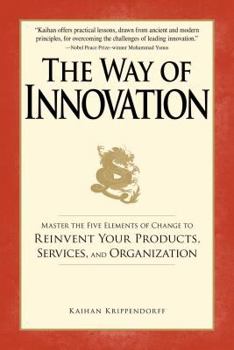The Way of Innovation: Master the Five Elements of Change to Reinvent Your Products, Services, and Organization
Inside The Way of Innovation, corporate strategist Kaihan Krippendorff explains how you can adapt and thrive by recognizing, understanding, and utilizing the ancient Asian approach to innovation. He illustrates how companies like Microsoft and Nokia use this powerful wisdom, and how you too can pass through the five stages of innovation: Metal (Admit you are stuck)Water (Conceive new winning options)Wood (Assemble your resources)Fire (Break...
Format:Paperback
Language:English
ISBN:1598693794
ISBN13:9781598693799
Release Date:July 2008
Publisher:Platinum Press Inc.
Length:256 Pages
Weight:0.86 lbs.
Dimensions:0.8" x 7.1" x 9.0"
Related Subjects
Business Business & Investing Economics Management Management & Leadership Systems & PlanningCustomer Reviews
3 ratings
Metal, Water, Wood, Fire, and Earth all have something to teach entrepreneurs on improving their com
Published by Thriftbooks.com User , 15 years ago
Traditional Chinese philosophy has more to offer than just food for one's soul - it can help one's business as well. "The Way of Innovation: Master the Five Elements of Change to Reinvent Your Products, Services, and Organization" is a guide to using the eastern elements of change to push change in your business. Metal, Water, Wood, Fire, and Earth all have something to teach entrepreneurs on improving their company, and "The Way of Innovation" will teach readers how.
Mastering Innovation the Eastern way
Published by Thriftbooks.com User , 15 years ago
Innovation is a hot topic (again!) in management circles these days. How do companies reinvent themselves to beat back competition and grow in size and value? Innovation hinges on change and creativity, both of which are notoriously difficult to manage or lead on demand. The usual management consulting techniques, tinkering with the mechanics of organizational structures and business processes tend to produce little if any improvement in innovation, which ties to more organic (and intangible) factors such as organizational culture and strategy. Kaihan Krippendorff's new book "The Way of Innovation" provides an important contribution to the literature on innovation, primarily by harkening back to principles of ancient Eastern philosophies of Buddhism and Taoism. Specifically, he provides a holistic strategic framework for instigating business innovation, deploying it, and perhaps most importantly, protecting and sustaining market gains deriving from those innovations. The first half of the book lays out this framework. The core of this framework is a model of the five phases of change, cast metaphorically in elemental terms as Metal (discontent), Water (imagination), Wood (formation, development); Fire (breakout, rapid growth), and Earth (consolidation, protection). Krippendorff also draws on other Eastern concepts such as dualism (material vs immaterial/conceptual realities, creation-destruction), Sun Tzu's models for framing conflict situations, and the strategic patterns he assembled for responding effectively. Krippendorff explains the five phases model of innovation in detail, albeit at a fairly high strategic level. For readers immersed in day-to-day tactical and operational concerns, this perspective may seem somewhat ethereal and uncomfortable, but I believe that it is an appropriate and necessary approach. Fortunately, Krippendorff supplies numerous business examples to illustrate and ground his points. The next section of the book reviews the five phases briefly, but this time supplies a set of guidelines, exercises, and templates for applying the framework to the reader's organization. Given the abstract nature of the framework, this rehearsal serves to reinforce the structure of the framework and add some welcome "how tos". The final section of the book presents eight case studies of innovative businesses, highlighting how those organizations dealt with each of the five phases of Krippendorff's framework. One (minor) disappointment is that Krippendorff's references to existing literature are generally oblique and anonymous - explicit footnotes naming key names and resources on innovation and competition (e.g., Geoffrey Moore, Clayton Christensen, Everett Rogers, Kim and Mauborgne, Gary Hamel, Michael Porter, would be very helpful to readers wanting to learn more. The Way of Innovation is a cogent and well written book. The framework Krippendorff suggests is genuinely insightful and helpful to leaders searching for ways to
Tying together the new with the old and tried
Published by Thriftbooks.com User , 15 years ago
"Innovation" is on everyone's mind but can be a buzzword whose meaning eludes us: common belief is that a small group of visionaries, somehow blessed with a gift, innovate for the rest of us. Kaihan turns this notion on its head and makes Innovation accessible to all who would learn and apply this ancient knowledge: He gives us a solid methodology, grounded in 5,000 years of tradition.




